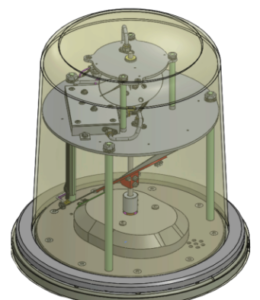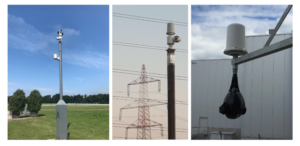In general, it is universally accepted that rotating radars are preferable when wide area coverage is required and a diverse set of targets must be correctly identified. Flat-panel radars are better suited to specialised applications with limited horizontal coverage and with fewer targets.
Beam Scanning and Target Detection
Flat-panel radars use either of two techniques to steer the beam over the coverage area: “Electronic Scanning” or “Angle-of-Arrival”.
“Electronic Scanning” works best when the beam scans over a narrow horizontal width. As the beam scans further left or right, the beam shape degrades, seriously affecting detection performance. Typically this degradation means targets can appear in the wrong location and targets from outside the coverage area will be detected and cause false alarms.
“Angle-of-Arrival” systems work by measuring the entire detection area with a very wide beam and then attempting to calculate the target position by mathematically comparing the received signals.
This system works well in empty environments with few targets, but performance rapidly degrades if multiple targets or other moving objects, trees, bushes and grass are within the coverage area. It is also impossible to distinguish between two targets at the same range but at different bearings.
In rotating radars like Scan-360, the beam is very narrow so trees and bushes do not degrade performance like in “Angle-of-Arrival” systems. The narrow beam is rotated mechanically to cover the entire 360-degree field of view; therefore the beam shape is never degraded like “Electronically Scanned” systems.
Rotating radars therefore provide superior performance for wide coverage areas and for environments that may have many possible targets as well as trees, bushes and grass.
Coverage Area Limitations
Many radar applications require wide horizontal scans, for example when mounting on the outside of a building to monitor the surrounding areas. Flat-panel radar is often unsuitable due to the limited horizontal coverage; so multiple units must be used to fill in any gaps.
Careful site planning is required to correctly position the multiple radars and to avoid interference between nearby units. In contrast,
a single Scan-360 covers the entire 360-degrees using a single radar unit.

Moving Parts and Reliability
Flat-panel radars often boast of “no moving parts” and their improved reliability compared to traditional rotating radar equipment. Scan-360, unlike other rotating radars, uses an ingeniously simple and elegant mechanical arrangement that has superb reliability.
Scan-360 uses lightweight materials, very low friction bearings and a very long-life motor. The mechanical load on the moving parts is extremely low, resulting in negligible wear. Scan-360’s elegant design eliminates the need for slip-rings and rotary waveguide joints that decrease reliability in traditional designs.
Flat-panel radars rely on additional electronic components to steer the beam.
Scan-360 uses mechanical scanning, so the electronic component count and complexity is reduced, therefore circuits will run cooler, which greatly increases the lifetime of the components, especially in warmer climates.
Summary
| Scan-360 target detection probability is excellent, even in challenging environments where flat-panel radars may struggle. |
| Scan-360 covers the entire 360-degree horizontal area using a single selfcontained unit to give the most straightforward and simple installation. |
| Scan-360’s robust and innovative design gives excellent reliability and high system availability, unlike older rotary radar systems. |